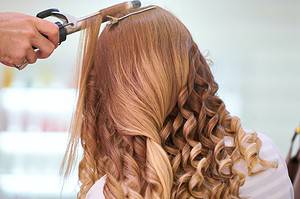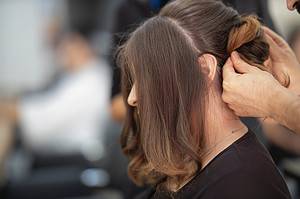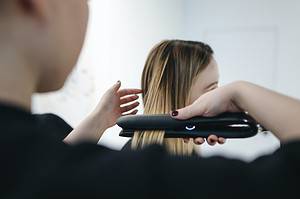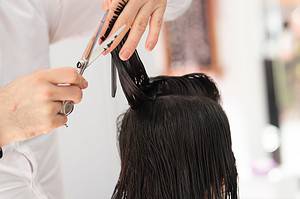Every woman should feel beautiful, but beauty should not be at the expense of their health and well-being.
According to new research by the Journal of the National Cancer Institute, persons who use chemical hair straightening products have a higher risk of contracting uterine cancer.
Compared to other people who do not use hair relaxers, regular users of hair relaxers had a risk of developing uterine cancer that was more than twice as high.
The study defines a regular user as someone who uses chemical relaxers to straighten their hair at least four times a year. Remember that endometrial cancer, the most prevalent type of uterine cancer, is considerably more likely to affect black women.
People use these products to style curvy or wavy hair since the products work by destroying hair structure. Unfortunately, individuals have to use them repeatedly to maintain the effect, which puts many users at risk of uterine cancer, breast cancer, and other illnesses.
Legal Giant is looking into the connection between chemical hair straighteners and uterine cancer. Here is everything you need to know about hair straightener uterine cancer lawsuits.
Chemical Hair Straightener Lawsuit – Higher Risk of Cancer
Hair products must adhere to the high safety requirements required of cosmetics to prevent these harmful consequences.
Customers expect the hair products they purchase will not endanger their health and be safe to use. So, one may use the possibility that these chemicals are carcinogenic as the basis for a chemical hair straightener lawsuit to seek redress.
Numerous hair straightener uterine cancer lawsuits were filed in the last month. Jennifer Mitchell filed the first lawsuit before the United States Federal Court for the Northern District of Illinois.

She claims that endometrial cancer, which she was diagnosed with at age 28, was caused by exposure to phthalates and other endocrine-disrupting chemicals in the hair relaxers she used.
Jennifer underwent a hysterectomy and has a lawsuit attributing hair relaxers to her uterine cancer.
You may be eligible for compensation if you have been diagnosed with endometrial cancer or other illness associated with exposure to chemical hair straighteners. Consider contacting hair relaxer cancer lawyers and product liability attorneys about the possibility of taking legal action.
Can Hair Relaxers Cause Cancer?
Most hair relaxer treatments that black women predominantly use contain endocrine-disrupting chemicals (EDCs). These EDCs tend to alter and interfere with the functioning of our endocrine system, which regulates the body’s synthesis of numerous hormones.
Diabetes, obesity, and myriad forms of cancer are just a few conditions that can develop when the endocrine system is disrupted.
Numerous studies have examined the link between EDCs and breast cancer, including the most current one from the National Institutes of Health.

These studies show that chemical hair relaxer products contain endocrine disruptors such as phthalates, parabens, and scents. Parabens, for example, are antibacterial preservatives commonly added to cosmetics.
According to a 2010 research in the journal Environmental Health Perspective, hair relaxer treatments frequently used by black women are to blame for the higher levels of parabens and phthalates discovered in black women.
This explains why, compared to white women, black women have significantly higher rates and more severe types of breast and endometrial cancer.
Hormone Related Cancers
Estrogen is essential for the growth and development of breast cancer, ovarian cancer, and endometrial cancer (uterine cancer).
Endocrine disruptors can cause cells to become overstimulated and contribute to the emergence of any of the three malignancies outlined above.
For this reason, we can no longer disregard the link between hair relaxers and ovarian, breast, or endometrial cancer.
Studies Show Great Impact of Hair Straightening Products
On October 17, the Journal of the National Cancer Institute released research examining the connection between consumer use of hair straightening and relaxing products and cancer incidence.
Concerns about the chemicals used in hair treatments and the potential harm they might do have long been a source of controversy. This current study follows others, including one published in the International Journal of Cancer.
It suggests a connection between hair dyes and straighteners and their roles in the growth of breast and ovarian cancers.

This most recent study looked at information from the Sister Study directed by the National Institute of Environmental Health Sciences (Cancer Epidemiology Group), which involved almost 34,000 American women aged 35 to 74.
These research participants responded to questionnaires regarding their usage of various hair products, such as hair dye, straighteners, relaxers, body waves, and hair pressing products.
Hair Straightener Chemicals Linked to Breast Cancer
Boston University conducted a 25-year study involving 59,000 black women to pinpoint breast cancer risk factors. According to the Boston University’s Black Woman Study, published in 2021, women who used lye-containing hair products at least seven times over fifteen years had a 30% increased chance of developing breast cancer.
Lye is one of the substances that scientists believe to be a risk factor for breast cancer. But further investigation is needed to understand why, compared to white women, black women have a significantly poorer survival rate and are more likely to have aggressive types of breast cancer.
Previous research on the association between hair straightening products and breast cancer was equivocal before this investigation.
The Statistics of Uterine Cancer Risk and Chemical Hair Straightener Usage
Out of the 33,497 individuals in the study, 378 cases of uterine cancer diagnosis were discovered. Only 1.64% of women said they had never used hair straightening products and developed uterine cancer by age 70.
On the other side, at the age of 70, 4.05% of women who admitted to regularly using chemical hair straighteners and relaxers had uterine cancer.
Frequent Users Have the Greatest Risk of Cancer
Compared to women who had never used chemical hair straighteners, those who often reported using these chemicals in the past year were shown to be at a greater risk of developing uterine cancer.
The risk of developing uterine cancer was higher in women who said they had used chemical hair straighteners four times in the previous year.
Although uterine cancer is relatively uncommon, and these numbers may not even reach the single digits, they show a significant increase in risk that might be linked to chemical hair straighteners.

Compared to research participants who never used hair straighteners, those who did observe a more than double increase in uterine cancer incidences.
Moreover, these may look like merely single-digit percentages. But when related to the number of women who use chemical hair straighteners, the percentage translates to thousands of uterine cancer cases.
What Hair Products Can Increase the Risk of Uterine Cancer?
The participants in the research published in the Journal of the National Cancer Institute were not asked which particular brands of chemical hair relaxers or straighteners they used or the ingredients in those products.
The study found that the risks of uterine cancer mentioned above applied to individuals who used chemical hair relaxers. However, hair dyes, highlights, and perms did not carry a similar causal relationship with uterine cancer.
Despite this, most of these products continue to be the subject of intense examination because previous research suggested a possible connection between them and other malignancies, such as breast cancer.

Researchers at the National Institute of Environmental Health Sciences (NIEHS) also used data from the Sister Study.
According to their investigation, 2,794 occurrences of breast cancer were linked to chemical hair straighteners, and women who used them often (at least once every five to eight weeks) had a 30% higher chance of getting the disease.
Why Does Chemical Hair Straightener Increase Uterine Cancer Risk?
The precise reason why hair straighteners are linked to a higher risk of uterine cancer is still a mystery to researchers. Studies have only established a link and provided some educated guesses about how they contribute to this risk.
However, based on a substantial body of scientific data, experts have concluded that the presence of endocrine disruptors in particular chemicals directly correlates with an elevated risk for various malignancies and health problems, including diabetes and obesity.

Studies have indicated that these hair treatments frequently contain aggressive chemical formulations required to break down your hair structure and transform it to the desired straight or relaxed state.
Scientists think that hair straighteners increase the chance of developing cancer since the cancers linked to these hair products typically result from hormonal disruptions.
Increased Uterine Cancer Risk Among Black Women
Although uterine cancer is regarded as a rare malignancy, research has shown that black women are diagnosed more frequently than other races. The findings of this investigation corroborate the higher risk of uterine cancer.
Black women comprised only 7.4% of participants in the National Institutes of Health study. Yet, 59.9% of them admitted to using chemical hair straighteners.
In a different study, researchers discovered that permanent hair dye usage among black women increased the risk of breast cancer diagnoses by 60%, compared to an 8% risk among Caucasian women.
The researchers did not find any link between uterine cancer and other hair products reportedly used by the women, including highlights, bleach, perms, and permanent hair dye, which alter natural hair.
That means endocrine-disrupting chemicals are in extraordinarily high concentrations in hair straightening treatments.
Is Straightening Hair Toxic for Black Women?
Researchers have long tried to figure out why uterine cancer strikes black women more frequently. The answer to this question may lie in the fact that black women make up the majority of users of chemical hair straighteners and relaxers.
Black women use hair straightening chemicals at a rate four times higher than white women. They use these products due to the pressure to meet eurocentric beauty standards and the desire for cosmetic adaptability.
In addition to using these products more often than women of other races, this group also uses them significantly earlier in life. Experts think early exposure to chemicals used in hair straightening is especially concerning since the scalp is more absorbent at younger ages.

Using hair straighteners can also result in burns and lesions, which can worsen the effects of chemical absorption into the scalp.
It’s also thought that black women are more likely to use several products at once, which may increase their chance of developing cancer. Additionally, other hair products barely increase the risk of uterine cancer.
There’s need to eradicate, or at the very least significantly reduce, health inequalities among black women.
Uterine Cancer and the Damage it Causes
As its name suggests, uterine cancer is a kind of cancer that develops in the uterus, generally in the lining (endometrium). It is among the most prevalent gynecological malignancies that affect the female reproductive system.
The disease is curable in the early stages through hysterectomy and other therapies like chemotherapy and immunotherapy. But this does not negate the reality that uterine cancer may be a very painful and upsetting sickness.
Any cancer has the potential to result in serious harm, including astronomical medical costs, lost income, emotional agony, and a reduction in quality of life.
Consumers have rights; thus, a mass torts case and product liability lawsuit should be considered when goods like chemical hair straighteners and relaxers lead to diseases as dangerous as uterine cancer.
The Future of Hair Relaxer Lawsuits
This week, several attorneys presented a motion asking the Judicial Panel on Multidistrict Litigation (JPML) to centralize all litigation filed under different federal judges and merge them into one case.
Eleven cases have been filed in four different federal courts so far. At its upcoming hearing, set for January 26, 2023, in Miami, the JPML is expected to consider arguments for forming a hair relaxer MDL.

In the upcoming weeks, we anticipate that hundreds of hair straightener cases will be filed in Federal Courts. For all the above reasons, an MDL for hair straightener uterine cancer lawsuits may likely be created very soon.
Contact a Lawyer for Your Hair Straightener Uterine Cancer Lawsuit
If you wish to participate in the ongoing MDL for hair straightener uterine cancer lawsuits, speak to an experienced product liability lawyer.
You might be eligible for compensation if you were diagnosed with uterine cancer after using chemical hair straightener products.
At Legal Giant, we can link you with the best product liability attorney who will help you understand your legal options and represent you in court.
Contact us today for a free consultation and review of your case.

